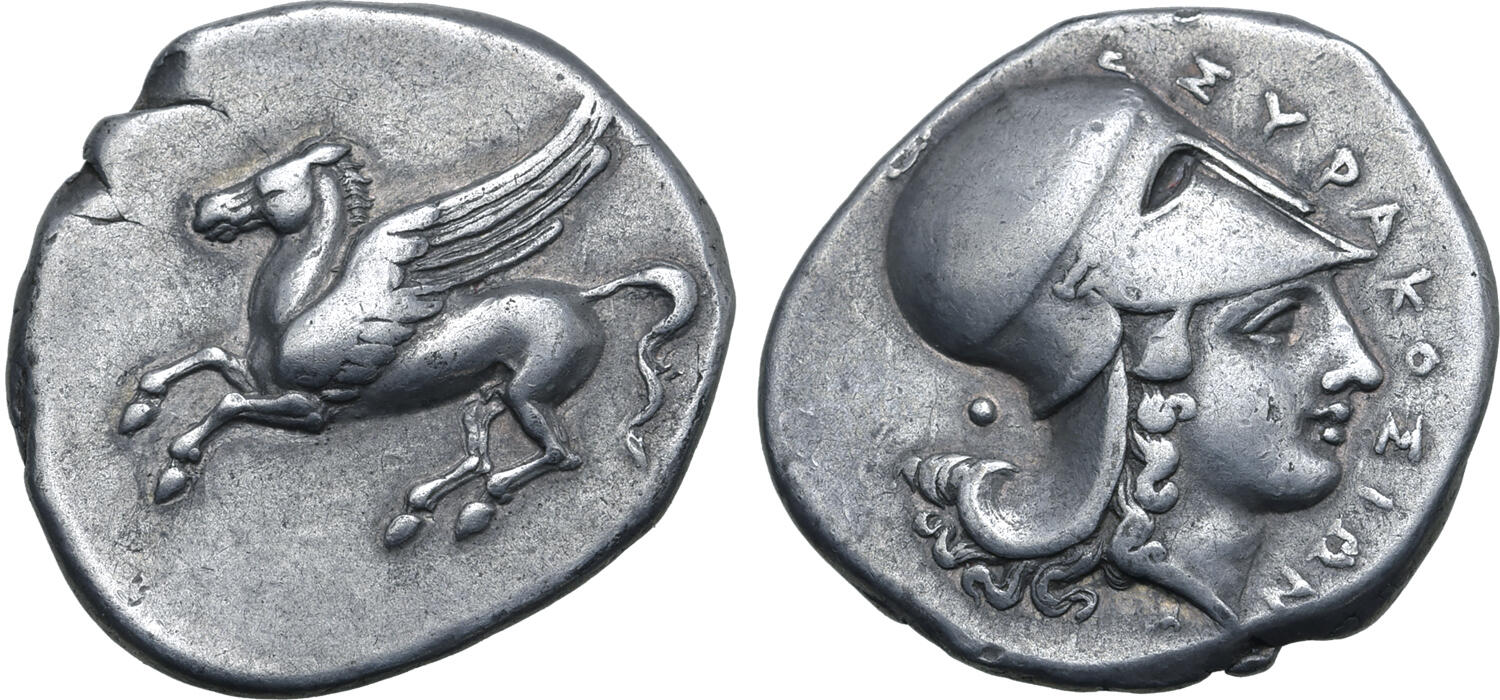Syracuse (Timoleon), silver, staters (Pegasus/Athena) (342-335 BCE)
From SILVER
(Redirected from S 1586 - Syracuse (Timoleon), silver, staters (342-335 BCE))
342 BCE - 335 BCE Silver 5,442 kg
Description
| ObverseInscription or printing placed on the obverse.: | Pegasos flying to left |
| ReverseInscription or printing placed on the reverse.: | ΣYPAKOΣIΩN around (Greek).Head of Athena to right, wearing Corinthian helmet, small pellet behind |
Mint and issuing power
| MintIdentifies the place of manufacture or issue of a numismatic object.: | Syracuse | Ancient regionAncient region.: | Sicily | Modern countryModern country: Italy | AuthorityIdentifies the issuing power. The authority can be "pretended" when the name or the portrait of X is on the coin but he/she was not the issuing power. It can also be "uncertain" when there is no mention of X on the coin but he/she was the issuing power according to the historical sources: | Timoleon of Corinth (411-337 BCE) |
Chronology
| FromIdentifies the initial date in a range assigned in a numismatic context. | 342 BCE | toIdentifies the final date in a range assigned in a numismatic context.. | 335 BCE | PeriodTime period of the numismatic object.: Classical 480-323 BC |
Physical description
| MetalThe physical material (usually metal) from which an object is made.: | Silver |
Median weightMedian of the weights of numismatic objects (in grams). in grams | 8.50 | DenominationTerm indicating the value of a numismatic object. Examples: tetradrachm, chalkous, denarius.: | stater |
StandardStandard.: | Attic |
Image

S1586 Syracuse Timoleon argent.jpg [1]
References
| Die study referencePublication of the study: | Hochard 20221Hochard 2022, p. 49-60 | ||
| Coin series referenceReference to coin series study: | SNG ANS 5 Sicily2SNG ANS 5 Sicily, n° 494-510, Sear I3Sear I, n° 961, HGC 24HGC 2, n° 1400 | ||
| Coin series web referenceCoin series web references: | |||
Obverse dies distribution
| FrequencyFrequency of specimen in distribution. ᵖ | Number of obversesNumber of obverse dies. ᵖ (o) | % (o) | Number of coinsNumber of coins. (n) | % (n) | Die nameName(s) of the die(s). |
| 1 | 8 | 25.81 | 8 | 3.08 | 17, 19, 20, 28, 29, 31, 37, 40 |
| 2 | 3 | 9.68 | 6 | 2.31 | 11, 34, 36 |
| 3 | 4 | 12.9 | 12 | 4.62 | 13, 33, 35, 38 |
| 4 | 2 | 6.45 | 8 | 3.08 | 12, 16 |
| 5 | 1 | 3.23 | 5 | 1.92 | 21 |
| 6 | 1 | 3.23 | 6 | 2.31 | 10 |
| 8 | 2 | 6.45 | 16 | 6.15 | 18, 39 |
| 11 | 1 | 3.23 | 11 | 4.23 | 15 |
| 13 | 1 | 3.23 | 13 | 5 | 27 |
| 14 | 1 | 3.23 | 14 | 5.38 | 26 |
| 15 | 1 | 3.23 | 15 | 5.77 | 23 |
| 16 | 2 | 6.45 | 32 | 12.31 | 25, 32 |
| 25 | 1 | 3.23 | 25 | 9.62 | 14 |
| 29 | 2 | 6.45 | 58 | 22.31 | 22, 30 |
| 31 | 1 | 3.23 | 31 | 11.92 | 24 |
| Total | 31 of 31 | 100.03 | 260 of 260 | 100.01 |
Reverse dies distribution
no distribution is available
Quantification
| Number of obversesNumber of obverse dies. ᵖ (o) | 31 | Number of singletons (o1)The number of singleton coins. ᵖ | 8 |
| Number of reverse diesNumber of reverse dies. (r) | 63 | Number of coinsNumber of coins. (n) | 260 |
| Coins per obverse dieNumber of coins per obverse die. (n/o) | 8.39 | Coins per reverse dieNumber of coins per reverse die. (n/r) | 4.13 |
| Reverse per obverse ratioRatio of obverse dies divided by reverse dies. (r/o) | 2.03 | Percentage of singletons (o1)number of coins (n) divided by the number of singletons (o1) ᵖ | 25.81 % |
| Original number of dies (O) (Carter 1983 formula)The estimation of the number of coins according to Carter 1983 ᵖ | 32.01 | Coins struck if 20,000 as average productivity per dieCoins made if the average productivity for obverses (according to Carter) is 20,000. ᵖ | 640,200 |
| Original number of dies (O) (Esty 2011 formula)The estimation of the number of coins according to the singleton formula in Esty 2011 ᵖ (O) | 35.2 | Survival rate if 20,000 as average productivity per dieSurvival rate if average productivity is 20,000. ᵖ | 0.00041 |
| Coverage (o = % of O) (Esty 1984 formula)Esty 1984 - coverage (% of O) ᵖ (o = % of O) | 96.92% | Die productivity if survival rate 1/2,000Average productivity if survival rate is 1/2,000. ᵖ | 16,244.92 |
| Weight of silver (in kg) if 20,000 coins per die (O = Carter formula)Carter 1983 * Median weight * 20000 (*10 if gold or electrum) ᵖ | 5,442 kg <br /> 5,442 kg | Die productivity if survival rate 1/5,000Average productivity if survival rate is 1/5,000. ᵖ | 40,612.31 |
Remarks
References
- ^ Hochard, Pierre-Olivier (2022), "Le monnayage d'or et d'argent de Syracuse sous Timoléon et la "Troisième démocratie" ", Revue Numismatique, 179, p. 17-81.
- ^ Sylloge Nummorum Graecorum ANS 5. The Collection of the American Numismatic Society. Sicily 3. Syracuse-Siceliotes, New York, 1988,
- ^ Sear, David R. (1978), Greek coins and their values. Vol. I, Europe, London, xl, 316 p.
- ^ Hoover, Oliver D. (2012), The Handbook of Greek Coinage Series. 2. Handbook of the Coins of Sicily (Including Lipara). Civic, Royal, Siculo-Punic, and Romano-Sicilian Issues. Sixth to First Centuries BC, Lancaster-London, 489 p.